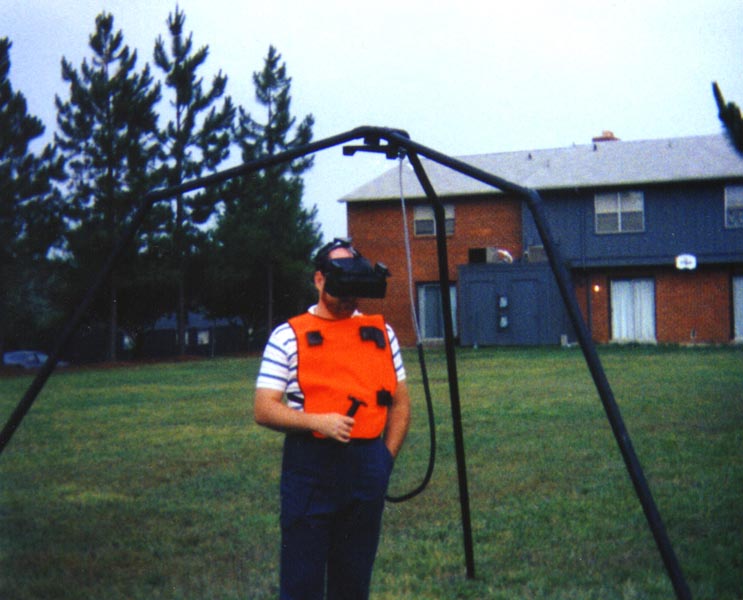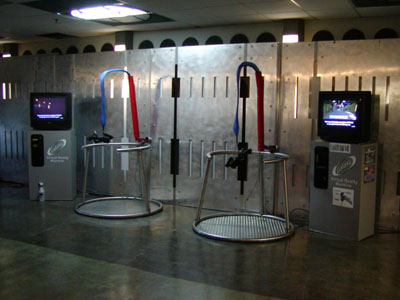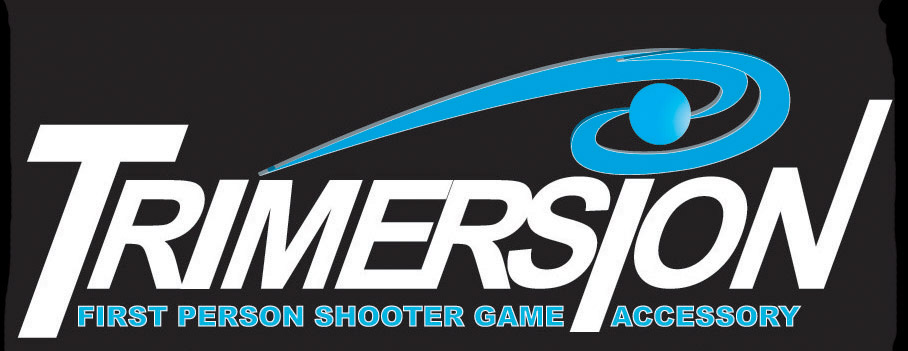
When I learned that eMagin increased their prices, I went back to look for other consumer HMDs. I contacted the makers of the Trimersion to know more about their tracking options.
Bob Ladrach, President and Chief Operating Officer of 3001 AD, makers of the Trimersion, answered me. He’s quite a VR geek too as you’ll see 😉 He shares his insight about the beginnings of the HMD and his thoughts about VR …
The origins
Best place to start is at the beginning.
The Trimersion isn’t a clone of existing visors. It evolved out of lots of trial and error developing prototypes, attractions and arcade games since 1994. Back then the least expensive HMD was $12,000 and was way out of my range. I put my own system together trackers, computer, HMD and input device for $3,000 with the help of a local businessman. The system was called Virtual Knight and ran on REND386 (one of the earliest open source VR toolkits).
The HMD was over 3 pounds and used a Logitech Red Baron ultrasonic head tracker and a modified power glove. The system allowed you to freely walk around in a 10ft. area and a virtual sword was attached to a plastic hilt. A knight in the center of an arena would swing at you if you got too close. Pretty simple but as a proof of concept, right on track.
Virtual Knight sat for a few years as I knew it would take significant funding to create a better version.

– Bob Ladrach testing the first VR system Virtual Knight in 1994 –
In 1997 I met Jimmy Barker, a venture capitalist and we shared a common vision about VR. We started 3001 AD in 1998 and began producing attractions called “Beta Zones” which were designed to be mini Disney Quests but on a much more realistic budget. We created 5 different virtual experiences that used V4 and V6 HMDs and Polhemus and Ascension trackers. The cost of the units was high and required many custom components.
As time passed it became more apparent that the cost of maintaining and updating hardware was prohibitive. People also tended to abuse the equipment. We began creating more durable hardware and simpler computer interfaces that made it easier to repair.
We developed a keyboard encoder interface with a tethered joystick controller. Even the tracker was re-designed using gyro technology to simplify and reduce the cost of the machines.
We began selling arcade systems with fairly few internal components and had finally reached the point where the entire VR system was not much more than a mini computer, HMD and input controller. The arcade systems at the time were selling for $15,000.
The arcade industry at the same time was declining. We decided to condense all of the technology into a single peripheral that would work with FPS games on the user’s own platform. This reduced the basic cost of the equipment and eliminated the software shelf life issue all together.

About eMagin and the evolution of HMDs
When we went to E3 in 2005 our price was $595 and emagin was $895
E3 2006 we dropped our price to $395 and emagin dropped theirs to $595Don’t know if we had anything to do with it but it was kind of funny.
emagin is the closest product IMHO
I do believe it is not a good idea to increase retail pricing. We had to make some hard decisions in the optics on the Trimersion. Originally we rolled out QVGA LCDs. Our focus groups didn’t like it. We went up to VGA (640 x 480) and everything seems cool. Even though our cost per unit went up, we feel it was worth it to make the best product we can for the price. We could have increased the rez even further but we tempered every choice by the primary goal; to create a VR peripheral that would be in the price range of most high end gamers. The second goal was to make it easy to use and setup.
The Trimersion is also a very focused product designed for FPS gamers, not for watching movies, iPod or working on spread sheets. This allowed us to tailor the controls and functionality for typical FPS play and at the same time generic enough to work on most gaming platforms.
We have had many questions about 3D. While I love 3D HMDs most game consoles can’t display it. PCs can but primarily with a specific card and driver that can sometimes be a real pain to configure.
I thought it was interesting that in the first Virtuality game systems the HMDs were stereoscopic, when the second generation systems came out they also had gone monoscopic.
VR has gone through so many ups and downs. Public speculation was nuts in the early 90’s and some promising technologies popped up. When the first systems came out at $60,000 each and didn’t create the experience people expected, public interest wained and eventually VR became a bad word in some circles.
Most VR related companies are gone. HMDs have become video visors (essentially TVs strapped to your head) and the expectation of immersive environments has faded.
But quietly in the background the issues that plagued VR such as PC speed, software, component cost and innovation were being solved. VR arcade game design had stagnated and the POD concept still remains. (Keeping a player stationary with a waist high ring) I still remember back when I was developing Virtual Knight and other forum members were worried about letting a player walk around. Turns out most people don’t walk that much anyway.
VR has to reach a design culmination. Something that incorporates all of the innovations that held VR back. Once you can achieve the same quality (or better) in a VR game at home as the best theme park and arcade systems offered, then we reach the first milestone. This sets the baseline for new development and wraps up the loose ends from previous attempts. From here we can expand the concept of VR into new areas that are emerging rapidly.
VR was the first step and we are on the verge of incredible products that won’t just be game devices but will touch many diciplines.
We are already protoyping some of these devices and from what I’ve seen so far, we’re in for a ride.
As far as the V6 I think I still have 20 or so of them here in various states of inoperability. I used to pay $500 min a pop to have them repaired and had to start fixing them myself, I can strip a V6 and put it back together in a half hour now. Great skill but for what purpose? I agree with you on comfort and design, if you look at the Trimerison it has many of the features of the V6 and is just as comfortable.
Here’s some more information about the HMD…
The Trimersion HMD

Here’s a video of people playing with it. A bit static compared to Atrium, but as the head position is not tracked, moving is useless.
The Trimersion works on the PC as a mouse and keyboard through a USB connector. It doesn’t replace the mouse or keyboard but works in tandem. The gun controller is setup with Quake controls as default but can easily remap other games. The two triggers are assignable to favorite commands.
On Xbox, playstation and game cube control is through the game controller input. The gun has all of the buttons on standard gamepads. The mouse look is controlled by the head tracker in the HMD and can be assigned to either the left or right analog joystick with the flip of a switch.
The HMD has two 640 x 480 LCD displays, stereo over the ear headphones and a comfortable strap on the back.
The tracker is two axis measuring pitch and yaw, just like mouse look in an FPS game. Movement is with either the left or right analog joystick on the gun controller. [Cb’s note: the gun controller is not tracked in any way, it’s just buttons]
The HMD and gun controller has a wire connecting the two, they run on four double AA batteries for about 2 hours per use.
Video is sent from the PC or game console to the base station and then transmitted wirelessly to the HMD. The gun controls and tracking are sent back to the base station which is plugged into the game controller port or USB. Power for the base station comes from what it’s plugged into requiring no AC outlet.
A/V and Controller are transmitted at 2.4 GHz. With clear reception the range is around 15 feet.
The Trimersion is designed for FPS games but could be used for other purposes.
The price is $395 it is in production now and the first units are being shipped now.

– If you buy two Trimersion, you’ll get the babes –

Thanks much for sharing this. After this unit started shipping last Fall I thought I’d wait to see what the early reviews had to say. I’ve not yet read any, but I think I’ll go looking for them now that I’m reminded.
Need one !
i want the babes!
Looks like something for myself and all my friends. Glad to see they upped the resolution.
Have you seen any more new on these, or an availability date? Will there be a way to access the 2D head motion on the PC (mouse input, GlovePIE, …)? Thanks, a great article.
Ray
@Ray : I don’t have any more info about the HMD, I didn’t even saw it. It shouldn’t be too hard for them to emulate the mouse input, and I think that’s how they achieve the compatibility with existing FPS.
I called the company up to find out some details as I’ve been anticipating the advent of virtual reality for quite some time.
These units are being shipped as we speak. They will be making this unit compatible with playstation 3 and Xbox.
They are working right now on putting motion tracking in the gun as well, the first of it’s kind.
Trimersion looks like the leader in virtual reality right now. There is nobody that comes close to the technology of this company.
Emagin only connects to a PC. That’s the main competition and Emagin prices are at $1,500 compared to Trimersion’s retail price of $395.
It’s only a matter of time before Trimersion breaks into mainstream. There’s a big difference between playing a game and BEING the game. It’s the future. And the future is now.
The 3001ad seems very nifty. Are those models in the picture?
I think so.
Did anyone had the chance to try it ?
I got mine last week. I ordered it off the website
Man what a trip! You cant play standing up A swivel chair is perfect.
All my FPSs worked.
My favorite is UT2004. The motion tracked targeting is awsome. Even on long shots.
on a scale of 1 to 10
I would give it an easy 8.5
And it actually upped my score.
I have a Trimersion. The 2 DOF trackers work pretty well for FPS-like games. It was a smart choice from Bob Ladrach to limit the cost using only 2 gyros. Prices of gyros and other accelerometers are decreasing, so naturally they will go up to the 6 DOF, with a good design…
Things will become definitly great with a wider FOV (90 deg) and motion trackers in the gun controler. Bob please 😉
— ChrisQ
Any additional info about Trimersion? should I just assume that I have lost my entire investment? DANG!!!
http://www.nasdaq.com/aspx/stock-market-news-story.aspx?storyid=200909291551dowjonesdjonline000408&title=sec-charges-fraud-in-virtual-reality-cos-offerings
The Securities and Exchange Commission charged a virtual-reality technology company operated a boiler-room scheme to raise about $20 million from investors.
In a complaint filed in federal court in Florida, the regulator alleged 3001 AD LLC, its principals and three former sales agents raised the funds from 500 investors across the U.S. through unregistered offerings that touted promising products, including a helmet system for videogames.
3001 AD also repeatedly told investors that it was planning an initial public offering while doing nothing to lay the groundwork for such an offering, the SEC alleged. The company also hyped potential relationships with computing giants Microsoft Corp. (MSFT) and Apple Inc. (AAPL). In addition, it claimed it might be sold to Michael Eisner, even though the former Walt Disney Co. (DIS) chairman had already rebuffed 3001 AD’s advances.
“3001 AD promised a profitable future from the marketing and sale of its products, but instead was merely creating its own virtual reality for investors, ” said Glenn Gordon, associate director of the SEC’s Miami regional office. He added that up to 40 cents of every dollar raised was going to commissions. That amount was five times the figure cited in marketing materials.
3001 AD’s principals – Jimmy L. Barker, Robert J. Ladrach and Marc S. Rifkin – and former sales agents Ronald B. Bowsky, Jack W. Maddock and Michael J. Weidgans were charged with making several material misrepresentations and omissions to investors.
Attempts to reach 3001 AD were unsuccessful. The company’s listed telephone number has been disconnected, and its Web site appears to be no longer in operation.
-By Jay Miller, Dow Jones Newswires; 212-416-2355; jay.miller@dowjones.com
I have had my trimersion for two weeks now. Amazing, tho I did have to build a flywire cage to play it in. Wifi messes with signal playing at 1024x768x32 and it’s clear using ati radeon 3600 HD and a cord I made go from svideo to RCA yellow. Currently playing fear and it’s intense.
really ? where did you get it ??
You can get them on Amazon for about $90-100 a piece. Now that the company has gone under, they are pretty cheap.
Hello,
sorry if this is a dead topic but i was wondering if these are still available? and if anyone can post the link.
any and all help is greatly appreciated.
thanks
Keith.
Hi Keith,
I can’t find it anywhere. The company died a long time ago and I was never able to see one of those HMDs ..
http://www.fiberopticproducts.com/store/product_info.php?products_id=1428
I found a system at the link above..hope it helps…
Keith.
thanks for answering me,i really appreciate it.
Keith
Thanks for the link !
I might buy one when I create a VR museum 🙂
i just wanted to post this to help others out
this is a sight that has alot of older VR stuff..stuff i havnt seen ever and stuff i havnt seen in a long time,i hope it ends up being beneficial to someone out there.
http://www.pricedumper.com/virtual+reality
Keith
Great, thank you !
no problem
if they have more than 1,i might pick one up for myself,seems like something that will be fun to fiddle and foodle with..heck the motion tracking itself would be worth the price (though a kinect comes to mind which i think is the king of all motion trackers.
Keith.
again no problem=)
Keith
Keith, I wouldn’t get too excited about the tracker, which only does rotation, and probably doesn’t do it very well.
As for the HMD I don’t know what it’s worth, but the Vuzix ones are probably better..
oh i see…ill have to look the Vuzix up..never heard of them..I still have a Phillips Scuba system…looked great on the outside but the resolution was terrible!
Keith